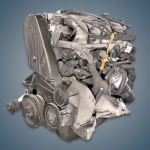The 2.0-liter mono-injection Audi ABT engine was assembled at the factory from 1991 to 1996 and was installed only on the popular fourth-generation 80 model in the B4 body. This power unit was equipped with a rather capricious Mono-Motronic fuel injection system.
The EA827 2.0l series includes: 2E, AAD, AAE, ABT, ABK, ADY, AGG, ABF, ACE.
Specifications
| Production years | 1991-1996 |
| Displacement, cc | 1984 |
| Fuel system | Mono-Motronic |
| Power output, hp | 90 |
| Torque output, Nm | 148 |
| Cylinder block | cast iron R4 |
| Block head | aluminum 8v |
| Cylinder bore, mm | 82.5 |
| Piston stroke, mm | 92.8 |
| Compression ratio | 8.9 |
| Features | SOHC |
| Hydraulic lifters | yes |
| Timing drive | belt |
| Phase regulator | no |
| Turbocharging | no |
| Recommended engine oil | 5W-30 |
| Engine oil capacity, liter | 3.0 |
| Fuel type | petrol |
| Euro standards | EURO 1 |
| Fuel consumption, L/100 km (for Audi 80 1993) — city — highway — combined |
10.5 6.2 7.5 |
| Engine lifespan, km | ~360 000 |
The engine was installed on:
- Audi 80 B4 (8C) in 1991 – 1995.
Disadvantages of the Audi ABT engine
- Most of the problems with this engine are due to the vagaries of the Mono-Motronic system.
- Malfunctions are usually caused by air leaks or a glitch in one of the sensors.
- In second place in popularity here are the failures of the components of the ignition system.
- The timing belt resource is approximately 90,000 km, but when it breaks, the valves most often do not bend.
- After 200,000 km, an oil burner often appears and hydraulic lifters knock hard.






